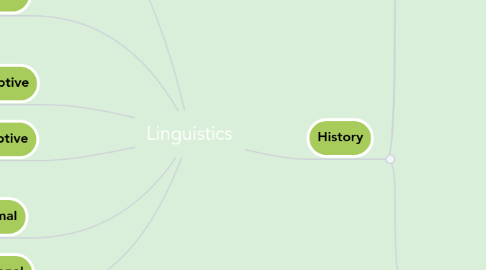
1. Descriptive
1.1. Language as it is actually used
2. Prescriptive
2.1. Language as it should be used
3. Applied
3.1. Second Language Acquisition
3.2. Computational
3.3. Forensic
4. Theoretical
4.1. Comparative
4.2. Sociolinguistics
4.3. Historical
5. Formal
5.1. Communication
6. Functional
6.1. Language
7. History
7.1. Antiquity
7.1.1. Babylonian Tradition
7.1.1.1. First linguistic texts (2000 B.C.)
7.1.2. Hindu Tradition
7.1.2.1. Sanskrit in religious texts (1000 B.C.)
7.1.2.2. Panini (500 B.C.)
7.1.3. Greek Tradition
7.1.3.1. Dionysius Thrax (100 B.C.)
7.1.3.1.1. First surviving grammar of an European language: Techne Grammatike
7.1.4. Roman Tradition
7.1.4.1. Varro (116-27 B.C.)
7.2. Middle Ages
7.2.1. Arabic and Hebrew Tradition
7.2.1.1. Arabic
7.2.1.1.1. 7th century A.D.
7.2.1.2. Hebrew
7.2.1.2.1. 9th century A.D.
7.2.2. Roger Bacon (1214-1294)
7.2.2.1. Universal nature of Grammar
7.3. European Colonialism
7.3.1. European family of languages
7.4. Modern Linguistics
7.4.1. Historical Linguistics
7.4.1.1. Rasmus Rask (1787-1832)
7.4.1.2. Romantic Linguistics
7.4.1.2.1. Wilhelm von Humboldt (1767-1835)
7.4.1.2.2. Franz Bopp (1791-1867)
7.4.1.3. August Schleicher (1821–1868)
7.4.1.3.1. Stammbaumtheorie (family-tree theory)
7.4.1.4. Neogrammarians
7.4.1.4.1. Second half 19th century
7.4.1.4.2. Goal
7.4.1.4.3. Comparative Philology
7.4.1.4.4. Idiolect
7.4.1.4.5. Focus
7.4.1.4.6. Protolanguage
7.4.1.4.7. Scholars
7.4.2. Structuralism
7.4.2.1. Ferdinand de Saussure (1857–1913)
7.4.2.1.1. Langue/Parole
7.4.2.1.2. Synchrony/Diachrony
7.4.2.1.3. Paradigm/Syntagm
7.4.2.1.4. Sign
7.4.2.2. Language as a system
7.4.2.3. Schools
7.4.2.3.1. Prague
7.4.2.3.2. British
7.4.2.3.3. Copenhague
7.4.2.3.4. American
7.4.3. Generativism
7.4.3.1. Mid 20th century
7.4.3.2. Noam Chomsky (1928)
7.4.3.2.1. Transformational Grammar
7.4.3.3. Goal
7.4.3.3.1. to explain language structure through genetically-shared language universals
7.4.3.4. Sentences
7.4.3.5. Components
7.4.3.6. Competence/Performance

